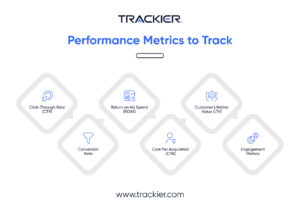A marketing campaign is a coordinated effort across channels, time-bound, and measured for results.
What is a Campaign?
A campaign in marketing is the sequence of coordinated activities and efforts to achieve a particular goal or objective, such as to increase brand awareness or generate traffic, leads, or sales. It can be run through various marketing channels like social media, email, digital ads, or influencer partnerships.
Campaigns are usually time-bound, with starting and finishing dates set, and are strategically planned for measurable output. KPIs are often used to measure the efficiency of a marketing campaign, such as CTR, conversion rates, ROI, etc.
Types of Marketing Campaigns
The channels and strategies for marketing campaigns vary with the specific goals and target audience. Some of the common types of campaigns include:
1. Digital Advertising Campaigns
These campaigns are based on online advertising platforms like Google ads, Meta ads, etc., to promote products or services to reach a large audience through targeted ads.
- Google Ads: Your ads will be placed all over Google’s search results and third-party websites based on the keyword relevance to a product or service.
- Meta Ads: Your sponsored ads on Meta platforms (Facebook, Instagram) are based on your target audience demographic, interest, or behavior.
2. Email Campaigns
Email campaigns are normally used for direct communication with a target audience for nurturing leads or simply retaining the existing customer base. Examples are:
- Drip campaigns: Automated, timed sequences of emails designed to guide users through a particular journey, such as onboarding or product education.
- Newsletters: Scheduled e-mails that regularly provide subscribers with updates, news, or curated content.
- Promotional Emails: Targeted emails about discount offers, new product launches, or offers before they sell out.
3. Social Media Campaigns
These campaigns use social media platforms to involve users, increase brand visibility, or promote specific actions. Examples include:
- Instagram Contests: Engage users with contests or giveaways whereby the user will need to follow, like, or comment on a post to win.
- Hashtag Campaign: Creating a particular hashtag for encouraging user-generated content and promoting brand awareness. An example would be a campaign that encourages customers to share their experiences regarding a particular brand using a particular hashtag.
4. Affiliate Marketing Campaigns
Affiliate marketing campaigns are focused on affiliate partnerships: individuals or companies who sell a brand’s products to earn a commission for sales or leads they have generated.
For example, Affiliate marketing is the promotion of products through affiliate links on blogs, websites, or social media channels, where an affiliate earns a commission for every sale or click generated through their referral.
5. Influencer Campaigns
These campaigns involve influencer collaborations that help to promote a brand, product, or service to their audience. Some examples include:
- Product reviews or sponsored posts: Influencers create content featuring a product and share it with followers to increase awareness or actual sales.
- Collaborations and Giveaways: Influencers partner with brands for special campaigns, such as offering exclusive discounts or running giveaways.
6. Content Marketing Campaigns
Content marketing campaigns are done by creating valuable content aimed at engaging, informing, or entertaining a target audience. Examples:
- Blogging: Posting articles or guides that solve problems for your audience and therefore attract organic traffic.
- Video Content Creation: Creating a video (or even a tutorial series, demo of a product, or explainer) for engagement on YouTube or social media.
- Infographics: Visual content that takes complex data or processes and simplifies them to be more accessible and shareable.
Key Elements of a Campaign
To run a successful campaign, there are many key elements that need to be defined. Each element ensures that the campaign is focused, measurable, and aligned with business objectives.
1. Objective
The objective of a campaign is what you want to achieve. It provides direction and focus for all other aspects of the campaign. Common objectives include:
- Brand Awareness: Increase brand visibility and recognition.
- Lead Generation: Collect contact information from prospects.
- Sales Conversion: Encourage purchases or subscriptions.
- Customer Retention: Keep the customers engaged and repeat purchases.
- Event Promotion: Get attendance and engagement for events, webinars, or launches.
2. Target Audience
Identifying who the target audience is is important so that it reaches the right people. This includes:
- Demographics: Age, gender, location, income level, etc.
- Psychographics: Interests, values, lifestyles, and behaviors.
- Buyer Personas: A detailed representation of ideal customers based on data and research. Knowing your audience will help tailor the messaging, creativity, and channels used in the campaign.
3. Message/Creative
The message/creative would represent the core communication of the campaign. It describes how you would present the campaign’s value proposition to the target audience. These include:
- Key Message: What do you want the audience to know, feel, or do? It should align with the objective of the campaign.
- Creative Assets: Visual and written content (pictures, videos, copy, graphics) through which the message could be communicated engagingly.
4. Channels
Channels are the modes or platforms by which a campaign would be implemented. Picking the appropriate channel helps the message to effectively hit the target audience. These common channels are:
- Social Media: Facebook, Instagram, Twitter, LinkedIn, and others.
- Email Marketing: Newsletters, promotional emails, and drip campaigns.
- Display Ads: Display banner ads, video display, retargeting.
- Search Ads: Google Ad or Bing Ad based on a word related to what has to be targeted.
- Influencer/Affiliate Channels: The relationship established between an influencer/ affiliate marketer.
Performance Metrics to Track in Campaign

Campaign tracking and performance metrics are essential measures to evaluate the effectiveness of a marketing campaign and identify potential areas for improvement.
If marketers track these metrics closely, they can make data-driven decisions to optimize their campaigns and amplify their impact. Here are some key performance metrics used to track and measure campaign success:
1. Click-Through Rate (CTR)
CTR means the frequency at which users are clicking on an ad, divided by impressions or how often it is presented to them. The higher CTR suggests that your ad is effective and of interest to viewers.
- Use Case: If you’re running Google Ads or social media ads, tracking CTR helps identify if your creative is compelling and if the targeting is accurate.
2. Conversion Rate
A measure of the percentage of the total visits or leads that make it an action, such as converting purchases, signing up for your newsletters, or filling in their contact form. This metric proves to be essential and useful in understanding how efficient a campaign is at leading to actual results.
- Use Case: For an e-commerce campaign, track and calculate the conversion rate to know who buys after clicking an advertisement.
3. Return on Ad Spend (ROAS)
ROAS is one of the most important metrics for measuring campaign profitability. It compares revenue from the campaign to the ad spend.
- Use Case: Using this example, if you spent $1,000 on ads and generated $5,000 in sales, the ROAS would be 5, meaning you earned $5 for every dollar spent.
4. Cost Per Acquisition (CPA)
CPA measures the cost of bringing a new customer or lead on board. It is the total campaign cost divided by the number of new customers or leads generated.
- Use Case: If you spend $2,000 and get 100 new leads, then the CPA would be $20 per lead.
5. Customer Lifetime Value (LTV)
LTV refers to the amount of revenue that can be generated from a customer during his lifetime relationship with your brand. Comparing LTV with CPA helps evaluate whether you are acquiring customers profitably.
- Use Case: If an average customer spends $500 per year and stays with your brand for 5 years, then the LTV would be $2,500.
6. Engagement Metrics
Engagement metrics analyze how users engage with your campaign content. This can include:
- Likes, Shares, and Comments: Measures an interaction with your content, especially on social media.
- Video Views/Completion Rates: For video campaigns, these metrics measure how many people watched and completed your video.
- Time on Site/Page Views: This measures how long people spend on your website or specific landing pages, which represents content engagement.
Manage Campaigns with Trackier
Trackier is a performance marketing software that makes campaign management easy. Here is exactly how it does this:
- Campaign Setup: Create your campaigns on multiple channels, including ads, affiliates, and email. You can also create audience-targeting and tracking links.
- Manage Your Partners: Monitor how your affiliates have been performing and set their commission.
- Real-Time Tracking & Analytics: Monitor Clicks, leads, and sales in real-time with customization on any report.
- Fraud Detection: With Trackier, you can identify & block fraudulent clicks that will eventually save your ad budget.
- Budget Management: Tracking the campaign budget is a challenging task. On the Trackier dashboard, you can set or track your campaign budget, along with spending limits.
- Collaboration and Integration: For a huge business, collaboration and integration are necessary. With us, you can assign your team members to a specific task while integrating software like Salesforce, HubSpot, etc.




